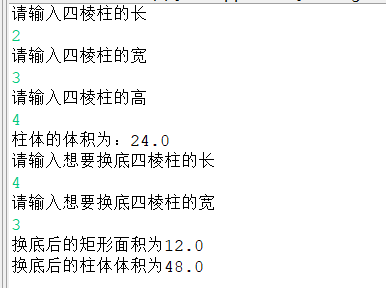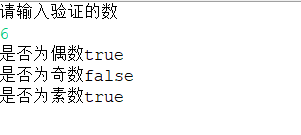题目1:在作业5的基础上,再创建一个柱体类,包含矩形对象、高和体积等三个成员变量,一个构造方法进行成员变量初始化,和计算体积、换底两个功能方法,在主类中输入长、宽、高,计算柱体体积,输入新的长、宽、高,创建新的矩形对象,并利用换底方法换底,再次计算柱体体积。
1.代码
//矩形类
package QQQ;
public class Rect{
double a,b,area;
public Rect(double a,double b){
this.a=a;
this.b=b;
}
public double getArea(){ //面积方法
return area=a*b;
}
}
package QQQ; //四棱柱类
import QQQ.Rect;
public class Cone {
Rect rect ; //创建对象
double h;
double v;
Cone(double h,Rect rect){ //构造方法
this.h=h;
this.rect=rect;
}
public double getV() {
return v=h*rect.getArea();
}
public void setRect(Rect rect){
this.rect=rect;
}
}
package QQQ; //主类
import java.io.Reader;
import java.util.Scanner;
public class Test {
public static void main(String[] args) {
// TODO Auto-generated method stub
Scanner reader=new Scanner(System.in); //将长宽高进行输入操作
System.out.println("请输入四棱柱的长");
double a=reader.nextDouble();
System.out.println("请输入四棱柱的宽");
double b=reader.nextDouble();
System.out.println("请输入四棱柱的高");
double h=reader.nextDouble();
Rect rect=new Rect(a,b); //定义矩形类对象
Cone c=new Cone(h,rect); //定义柱体类对象
System.out.println("柱体的体积为:"+c.getV());
System.out.println("请输入想要换底四棱柱的长"); //换底
double a1 =reader.nextDouble();
System.out.println("请输入想要换底四棱柱的宽");
double b1 =reader.nextDouble();
Rect rect1 = new Rect(a1, b1);
c.setRect(rect1); //调用换底方法
System.out.println("换底后的矩形面积为"+rect1.getArea());
System.out.println("换底后的柱体体积为"+c.getV());
}
}
2.输出结果

题目2:设计名为MyInteger的类,它包括: int型数据域value 一个构造方法,当指定int值时,创建MyInteger对象 数据域value的访问器和修改器 isEven( )和isOdd( )方法,如果当前对象是偶数或奇数,返回true 类方法isPrime(MyInteger i),判断指定的值是否为素数,返回true 在主类中创建MyInteger对象,验证MyInteger类中各方法。
1.代码
1 package WWW; 2 3 public class MyInteger { //MyInteger类 4 int value; 5 6 MyInteger(int value) { //构造方法 7 this.value=value; 8 } 9 10 11 public int setValue(){ //构造器 12 return value; 13 } 14 public void getValue(int value){ //修改器 15 this.value=value; 16 } 17 public boolean isEven(int value){ //偶数方法 18 if(value%2==0) 19 return true; 20 return false; 21 } 22 public boolean isOdd(int value){ //奇数方法 23 if(value%2!=0) 24 return true; 25 return false; 26 } 27 public static boolean isPrime(MyInteger m){ //素数方法 28 for(int i=2;i<m.value;i++){ 29 if (m.value%i==0){ 30 return true; 31 32 } 33 34 } 35 return false; 36 37 } 38 public static void main(String[] args) { 39 // TODO Auto-generated method stub 40 41 } 42 43 }
1 package WWW; 2 3 import java.util.Scanner; 4 5 public class Test { //主类 6 7 MyInteger myInteger =new MyInteger(0); //创建对象 8 public static void main(String[] args) { 9 Scanner reader=new Scanner(System.in); 10 System.out.println("请输入验证的数"); 11 int n =reader.nextInt(); 12 MyInteger my =new MyInteger(n); 13 System.out.println("是否为偶数"+my.isEven(n)); 14 System.out.println("是否为奇数"+my.isOdd(n)); 15 System.out.println("是否为素数"+my.isPrime(my)); 16 17 } 18 19 }
2.运行结果
